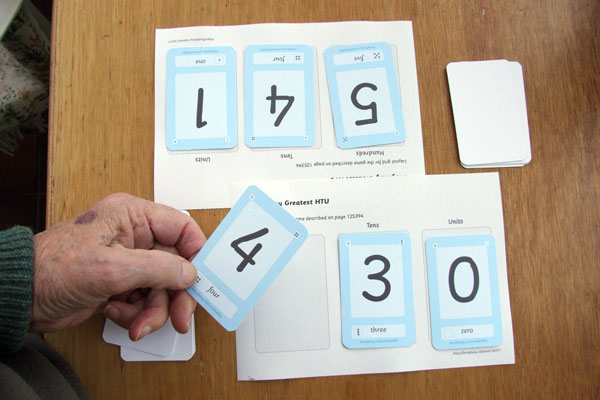
It looks as if North wins this round
This is the same game as the Tens and Units version [125390] ~ with the addition of a Hundreds column.

The rules for HTU are the same as for TU ~ with two minor changes. Firstly three columns are used in each round ~ hence the H~T~U. Secondly I propose that ~ at any time ~ once per game ~ a player may choose to discard one card they deem unsuitable for play ~ and then risk playing the next card in the pile. If no card is discarded during a game the last card is automatically 'out'. A game will now consist of three rounds, each using three cards. The rest of this page is redundant for those who are familiar with the rules. For those unfamiliar with them ~ they are re-written here.
The game is suitable for several players. Each player requires the ten digits ~ from 0 to 9 ~ printed on slips of paper or cards. A set of cards is available for sale at [shop].
Without looking at the face of the the cards each player shuffles or cuts the ten cards in hand ~ then passes them to the next player on the left.
Each player needs a grid in front of them. For this game the layout of the grid is three spaces ~ representing the columns for Hundreds, Tens and Units. A suitable format for home printing ~ two at a time ~ is available as a jpg [126976] or pdf [126976] .

The first player looks at the top card from the pile and thinks about where to place it on the grid. The aim is to make a larger number than anyone else by playing greater cards in the most useful position ~ whilst being aware of other cards that have been played and are yet to appear. Once played a card cannot moved until the end of the round.

Play continues round the table until each player has completed his/her grid of three columns (H,T,U). One card may be discarded if ~ when about to be played ~ it is deemed unsuitable. The person with the greatest number after each round 'wins' that round and scores a point. After three rounds all the cards will have been used and the game is over. The player with the highest total score of the three rounds wins.
The values of the numbers in the columns ~ read as a numeral of hundreds, tens and units ~ are compared between the players. The higher ~ highest ~ number 'wins' that round.
A game consists of three rounds in all. Players will ~ if their memory serves them right ~ have an idea of the cards they still have available to play in the later rounds. Unfortunately that does not help all that much with the random nature of the cards in the pile ~ a fair bit of judgement is required as to where to place cards.
Because the cards are in random order then chance has a great deal of influence on determining the winner of each round, or of the game. It is not a great test of skill ~ do not set too much store by the result. The main aim is to enjoy things ~ whilst learning to appreciate the value of numbers ~ and their hugely increased value if they are placed in the tens or hundreds column.
Another version of this game ~ slightly simpler ~ with two columns ~ TU ~ is available [125390].
The Elbe series of BusyBusy cards ~ and their purpose ~ is fully described [elbe].
A single set of the ten digit cards is sold in our secure shop as the Dresden Set [dresden]. Other combinations of cards and symbols are available.
